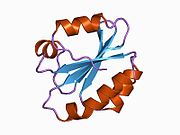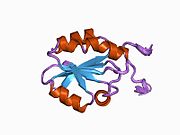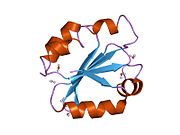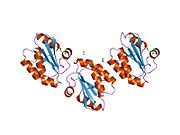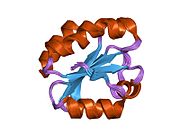Thioredoxin
Ensembl | |||||||||
|---|---|---|---|---|---|---|---|---|---|
| UniProt | |||||||||
| RefSeq (mRNA) | |||||||||
| RefSeq (protein) | |||||||||
| Location (UCSC) | Chr 9: 110.24 – 110.26 Mb | Chr 4: 57.94 – 57.96 Mb | |||||||
| PubMed search | [3] | [4] | |||||||
| View/Edit Human | View/Edit Mouse |
Thioredoxin (TRX or TXN) is a class of small
Occurrence
They are found in nearly all known organisms and are essential for life in mammals.[8][9]
Function
The primary function of thioredoxin (Trx) is the reduction of oxidized cysteine residues and the cleavage of disulfide bonds.
Structure and mechanism
Thioredoxin is a 12-kD oxidoreductase protein. Thioredoxin proteins also have a characteristic
For Trx1, this process begins by attack of Cys32, one of the residues conserved in the thioredoxin CXXC motif, onto the oxidized group of the substrate.[14] Almost immediately after this event Cys35, the other conserved Cys residue in Trx1, forms a disulfide bond with Cys32, thereby transferring 2 electrons to the substrate which is now in its reduced form. Oxidized Trx1 is then reduced by thioredoxin reductase, which in turn is reduced by NADPH as described above.[14]

Trx1 can regulate non-redox post-translational modifications.[15] In the mice with cardiac-specific overexpression of Trx1, the proteomics study found that SET and MYND domain-containing protein 1 (SMYD1), a lysine methyltransferase highly expressed in cardiac and other muscle tissues, is also upregulated. This suggests that Trx1 may also play an role in protein methylation via regulating SMYD1 expression, which is independent of its oxidoreductase activity.[15]
Interactions
Thioredoxin has been shown to
- ASK1,[16][17][18]
- Collagen, type I, alpha 1,[19]
- Glucocorticoid receptor,[20]
- SENP1,[21]
- TXNIP.[22]
- NF-κB – by reducing a disulfide bond in NF-κB, Trx1 promotes binding of this transcription factor to DNA.[23]
- AP1 via Ref1 – Trx1 indirectly increases the DNA-binding activity of activator protein 1 (AP1) by reducing the DNA repair enzyme redox factor 1 (Ref-1), which in turn reduces AP1 in an example of a redox regulation cascade.[24]
- cardiomyocytes is preserved during oxidative stress due to an interaction between AMPK and Trx1. By forming a disulfide bridge between the two proteins, Trx1 prevents the formation and aggregation of oxidized AMPK, thereby allowing AMPK to function normally and participate in signaling cascades.[25]
Effect on cardiac hypertrophy
Trx1 has been shown to downregulate cardiac hypertrophy, the thickening of the walls of the lower heart chambers, by interactions with several different targets. Trx1 upregulates the transcriptional activity of nuclear respiratory factors 1 and 2 (NRF1 and NRF2) and stimulates the expression of peroxisome proliferator-activated receptor γ coactivator 1-α (PGC-1α).[26][27] Furthermore, Trx1 reduces two cysteine residues in histone deacetylase 4 (HDAC4), which allows HDAC4 to be imported from the cytosol, where the oxidized form resides,[28] into the nucleus.[29] Once in the nucleus, reduced HDAC4 downregulates the activity of transcription factors such as NFAT that mediate cardiac hypertrophy.[14] Trx 1 also controls microRNA levels in the heart and has been found to inhibit cardiac hypertrophy by upregulating miR-98/let-7.[30] Trx1 can regulate the expression level of SMYD1, thus may indirectly modulate protein methylation for purpose of cardiac protection.[15]
Thioredoxin in skin care
Thioredoxin is used in skin care products as an antioxidant in conjunction with glutaredoxin and glutathione.[citation needed]
See also
- RuBisCO - enzyme activity regulated by thioredoxin
- Peroxiredoxin - enzyme activity regulated by thioredoxin
- Thioredoxin fold
- Thioredoxin reductase
References
- ^ a b c GRCh38: Ensembl release 89: ENSG00000136810 – Ensembl, May 2017
- ^ a b c GRCm38: Ensembl release 89: ENSMUSG00000028367 – Ensembl, May 2017
- ^ "Human PubMed Reference:". National Center for Biotechnology Information, U.S. National Library of Medicine.
- ^ "Mouse PubMed Reference:". National Center for Biotechnology Information, U.S. National Library of Medicine.
- PMID 3170595.
- ^ "Entrez Gene: TXN2 thioredoxin 2".
- ^ PMID 20133584.
- PMID 2668278. Archived from the original(PDF) on 2007-09-29. Retrieved 2007-02-23.
- PMID 11728801.
- PMID 9143692.
- ^ "Entrez Gene: TXN thioredoxin".
- PMID 10657232.
- PMID 11012661.
- ^ PMID 27993729.
- ^ PMID 26410624.
- PMID 12089063.
- PMID 11689443.
- PMID 9564042.
- PMID 12099690.
- PMID 9915858.
- PMID 18219322.
- PMID 10419473.
- PMID 1508666.
- PMID 9108029.
- PMID 24506865.
- PMID 16987018.
- PMID 14597765.
- PMID 23271793.
- S2CID 2678474.
- PMID 21183740.
Further reading
- Arnér ES, Holmgren A (October 2000). "Physiological functions of thioredoxin and thioredoxin reductase". European Journal of Biochemistry. 267 (20): 6102–9. PMID 11012661.
- Nishinaka Y, Masutani H, Nakamura H, Yodoi J (2002). "Regulatory roles of thioredoxin in oxidative stress-induced cellular responses". Redox Report. 6 (5): 289–95. S2CID 34079507.
- Ago T, Sadoshima J (November 2006). "Thioredoxin and ventricular remodeling". Journal of Molecular and Cellular Cardiology. 41 (5): 762–73. PMID 17007870.
- Tonissen KF, Wells JR (June 1991). "Isolation and characterization of human thioredoxin-encoding genes". Gene. 102 (2): 221–8. PMID 1874447.
- Martin H, Dean M (February 1991). "Identification of a thioredoxin-related protein associated with plasma membranes". Biochemical and Biophysical Research Communications. 175 (1): 123–8. PMID 1998498.
- Forman-Kay JD, Clore GM, Wingfield PT, Gronenborn AM (March 1991). "High-resolution three-dimensional structure of reduced recombinant human thioredoxin in solution". Biochemistry. 30 (10): 2685–98. PMID 2001356.
- Jacquot JP, de Lamotte F, Fontecave M, Schürmann P, Decottignies P, Miginiac-Maslow M, Wollman E (December 1990). "Human thioredoxin reactivity-structure/function relationship". Biochemical and Biophysical Research Communications. 173 (3): 1375–81. PMID 2176490.
- Forman-Kay JD, Clore GM, Driscoll PC, Wingfield P, Richards FM, Gronenborn AM (August 1989). "A proton nuclear magnetic resonance assignment and secondary structure determination of recombinant human thioredoxin". Biochemistry. 28 (17): 7088–97. PMID 2684271.
- Tagaya Y, Maeda Y, Mitsui A, Kondo N, Matsui H, Hamuro J, Brown N, Arai K, Yokota T, Wakasugi H (March 1989). "ATL-derived factor (ADF), an IL-2 receptor/Tac inducer homologous to thioredoxin; possible involvement of dithiol-reduction in the IL-2 receptor induction". The EMBO Journal. 8 (3): 757–64. PMID 2785919.
- Wollman EE, d'Auriol L, Rimsky L, Shaw A, Jacquot JP, Wingfield P, Graber P, Dessarps F, Robin P, Galibert F (October 1988). "Cloning and expression of a cDNA for human thioredoxin". The Journal of Biological Chemistry. 263 (30): 15506–12. PMID 3170595.
- Heppell-Parton A, Cahn A, Bench A, Lowe N, Lehrach H, Zehetner G, Rabbitts P (March 1995). "Thioredoxin, a mediator of growth inhibition, maps to 9q31". Genomics. 26 (2): 379–81. PMID 7601465.
- Qin J, Clore GM, Kennedy WM, Huth JR, Gronenborn AM (March 1995). "Solution structure of human thioredoxin in a mixed disulfide intermediate complex with its target peptide from the transcription factor NF kappa B". Structure. 3 (3): 289–97. PMID 7788295.
- Kato S, Sekine S, Oh SW, Kim NS, Umezawa Y, Abe N, Yokoyama-Kobayashi M, Aoki T (December 1994). "Construction of a human full-length cDNA bank". Gene. 150 (2): 243–50. PMID 7821789.
- Qin J, Clore GM, Gronenborn AM (June 1994). "The high-resolution three-dimensional solution structures of the oxidized and reduced states of human thioredoxin". Structure. 2 (6): 503–22. PMID 7922028.
- Gasdaska PY, Oblong JE, Cotgreave IA, Powis G (August 1994). "The predicted amino acid sequence of human thioredoxin is identical to that of the autocrine growth factor human adult T-cell derived factor (ADF): thioredoxin mRNA is elevated in some human tumors". Biochimica et Biophysica Acta (BBA) - Gene Structure and Expression. 1218 (3): 292–6. PMID 8049254.
- Qin J, Clore GM, Kennedy WP, Kuszewski J, Gronenborn AM (May 1996). "The solution structure of human thioredoxin complexed with its target from Ref-1 reveals peptide chain reversal". Structure. 4 (5): 613–20. PMID 8736558.
- Weichsel A, Gasdaska JR, Powis G, Montfort WR (June 1996). "Crystal structures of reduced, oxidized, and mutated human thioredoxins: evidence for a regulatory homodimer". Structure. 4 (6): 735–51. PMID 8805557.
- Andersen JF, Sanders DA, Gasdaska JR, Weichsel A, Powis G, Montfort WR (November 1997). "Human thioredoxin homodimers: regulation by pH, role of aspartate 60, and crystal structure of the aspartate 60 --> asparagine mutant". Biochemistry. 36 (46): 13979–88. PMID 9369469.
- Maruyama T, Kitaoka Y, Sachi Y, Nakanoin K, Hirota K, Shiozawa T, Yoshimura Y, Fujii S, Yodoi J (November 1997). "Thioredoxin expression in the human endometrium during the menstrual cycle". Molecular Human Reproduction. 3 (11): 989–93. PMID 9433926.
- Sahlin L, Stjernholm Y, Holmgren A, Ekman G, Eriksson H (December 1997). "The expression of thioredoxin mRNA is increased in the human cervix during pregnancy". Molecular Human Reproduction. 3 (12): 1113–7. PMID 9464857.
- Maeda K, Hägglund P, Finnie C, Svensson B, Henriksen A (November 2006). "Structural basis for target protein recognition by the protein disulfide reductase thioredoxin". Structure. 14 (11): 1701–10. PMID 17098195.
External links
- Thioredoxin at the U.S. National Library of Medicine Medical Subject Headings (MeSH)
- Overview of all the structural information available in the PDB for UniProt: P10599 (Thioredoxin) at the PDBe-KB.

